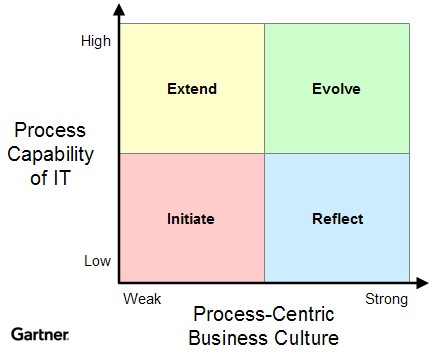After Sinur and Melenovsky’s welcome, Simon Hayward gave a great opening keynote yesterday, “Living in a process-centric world”. To quote the session description on the agenda:
Process is now gaining importance as an organizing concept for dealing with change at all levels. We live in a world of processes, becoming conscious of those processes and taking control of them can be the key to personal and corporate effectiveness.
As one attendee mentioned later, everything sounds more intelligent when it’s said with a British accent, and I have to admit to having a soft spot for anyone that says process with an “oh” rather than an “aw”. However, Hayward had some good content for us as well.
He started with the question of why we’re all thinking about process now, and linked it back to the fact that leaders in the industry became that way in part because of their focus on process — especially processes that touch their trading partners and customers. There are challenges around maintaining control over and having visibility into outsourced processes, as well as determining intellectual property rights in cases where the process itself may be a competitive differentiator.
Along the way, he floated the notion that agility (the ability to react to unexpected change) is becoming as, or more, important than innovation, and as I mentioned in a previous post, I interpret this to mean that reacting to market forces can actually be considered innovation if it’s done in the right way.
Another key point was compliance = explicit process management (taken from their 2005 Planning Guidance for Compliance report), which shows how process forms an integral part of compliance. I created a course on compliance for a customer last year, and process was a surprisingly large part of it: I found that if you can’t understand, control and report on your processes, you’re going to have a hard time getting compliant and proving it.
Then something came up for the second time that morning: Six Sigma. It appears that Gartner is making a strong link between Six Sigma and BPM at this conference (and likely in other research of theirs), although I found the Mikel Harry keynote this morning out of place, somehow, especially when he appeared to be using Six Sigma as a “brand” of sorts and distancing himself from the original statistical meaning. BPM certainly helps to provide a “closed loop” environment for Six Sigma’s Define, Measure, Analyze, Improve, Control (DMAIC) continuous process improvement cycle through the inclusion of process analytics and simulation, but I think that it’s a bit dangerous to downplay the statistical significance and rigor of Six Sigma to somehow make it friendly to the BPM crowd. Hayward later showed a graph of overlaid hype cycles that showed BPM as the current incarnation of trends that start with quality (process improvement) and migrate through process reengineering to BPM. I don’t disagree, but that doesn’t mean that BPM is the next “version” of Six Sigma somehow.
Getting back to Hayward’s talk, he had a good list of the IT disciplines needed for a process-centric environment, with a necessary focus on impact analysis and selective regression testing: if we’re putting all that emphasis on agility, we’d better be able to understand the ripple effects of changes and be able to test scenarios before deploying them. He talked about how to assess both IT and business for their current state of process centricity, and showed a chart of how to approach the various scenarios:

I like the “Reflect” quadrant, where the business is ready and IT isn’t: that’s when the business needs to do some serious prioritization due to the limited capacity of IT, or find some other ways to do things.
He finished up with a list of great recommendations including having less respect for silos and getting rid of baronial hostility that really point to one of the key issues in a process-centric organization: process is part of the infrastructure, not just embedded in some departmental systems.

I have been working for the last 3 years on mutiple technologies in document management system and workflow managetment system.as part of that i was observing te trend of mergers of technology vendors contributing to the significant amount of instability to the the clainr market space.I have lot of thoughts where this whole trend is directed to …
I would like to share ideas if given a chance..